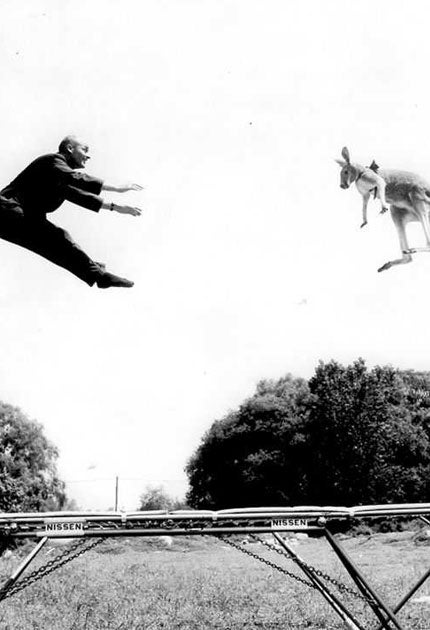George Nissen: Inventor of the trampoline

In 1930, the 16-year-old George Nissen watched in awe as trapeze artists performed their daring stunts at a travelling circus in Cedar Rapids, Iowa. Seeing them dismount at the end of their routines, dropping from their swinging bars and bouncing into a safety net below set the keen gymnast and swimmer thinking about how the performers' act would be even more spectacular if they could continue bouncing and doing more tricks.
This led Nissen to come up with a piece of equipment he called a bouncing rig. Using his parents' garage as a workshop, he simply strapped a canvas sheet to a rectangular steel frame. In 1934, with Larry Griswold, his gymnastics coach at the University of Iowa, Nissen put more bounce into it by connecting the canvas to the frame using tyre inner tubes. (These were later replaced by coil springs.)
Nissen – who as a swimmer had been a member of his school's diving team – formed the "rebound tumbling" act the Three Leonardos in 1937 and performed in Mexico, where he discovered that the Spanish for a diving board was el trampolín. He added an "e" and registered "Trampoline" as a trademark for the invention.
Back in the United States, the trio performed at school assemblies, invited children to have a go on the contraption and found that it proved popular. Then, in 1942, the Griswold-Nissen Trampoline & Tumbling Company was formed, making trampolines commercially, although Griswold soon pulled out to concentrate on performing his own acrobatic act as "the Diving Fool".
The trampoline's use extended from circus tumblers and children to the training of American pilots and navigators during the Second World War. During this time, Nissen replaced the canvas with nylon webbing, which was being developed for parachute straps.
Later, American and Soviet astronauts used the trampoline in their training. The first Trampoline World Championships were held at the Royal Albert Hall, London, in 1964 and won by the Americans Dan Millman (men's) and Judy Wills (women's). Trampolining eventually became an Olympic sport at the 2000 Sydney Games.
Born in Blairstown, Iowa, in 1914, George Nissen was brought up in nearby Cedar Rapids. He joined his school gymnastics team at the age of 10, then a YMCA tumbling team that performed locally. Also a keen swimmer, he said he narrowly missed out on a place in the US Olympic diving squad in 1932.
Nissen left his brother to run his trampoline business when, in 1943, he joined the US Navy. After serving as a navigator on a destroyer, he became a flight instructor at St Mary's Pre-Flight Center, near Oakland, California, which was already using his invention.
In the post-war years, when Nissen faced competition from other companies and the first national "rebound tumbling" competition was held, he continued to promote the trampoline in demonstrations. At one of these in Kansas City, he met a Dutch aerial acrobat called Annie De Vries, invited her to join his act and married her in 1951.
For another demonstration, in Central Park, New York, he rented a kangaroo to perform with him. He discovered that he could put it at one end of the trampoline and, by bouncing at the other end, make it bounce, too.
During the 1950s, he took his invention round the world and donated a trampoline to the Soviet Union. There was some irony in the fact that Russia won the first Olympic gold medals for trampolining in the 2000 Olympics.
At the end of the 1950s, jump centres started to spring up across the US and Nissen was making millions of dollars a year. He even cited the then Vice-President, Richard Nixon, and the actor Yul Brynner as "backyard jumpers".
However, with such wide abuse of his Trampoline trademark by other companies, he let it lapse in the early 1960s. There was also bad publicity from cases of people getting injured.
Nissen revived the trampoline's popularity in the US by inventing the game of Spaceball, combining basketball and volleyball skills. Players have to throw a ball past their opponent, through a tunnelled, double-netted gantry, while bouncing. At the same time, Nissen produced new designs for gymnastics equipment such as parallel bars, pommel horses and balance beams.
But Nissen's enthusiasm for his original invention never waned. In 1977, he performed acrobatics in Egypt on a trampoline on top of a pyramid with a flattened top.
Nissen eventually sold his company but continued to come up with inventions such as the Laptop Exercycle for passengers on long-haul flights.
George Peter Nissen, inventor, businessman and acrobat: born Blairstown, Iowa 3 February 1914; married 1951 Annie De Vries (two daughters); died San Diego, California 7 April 2010.
Subscribe to Independent Premium to bookmark this article
Want to bookmark your favourite articles and stories to read or reference later? Start your Independent Premium subscription today.

Join our commenting forum
Join thought-provoking conversations, follow other Independent readers and see their replies